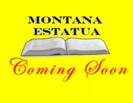

|
Montaña Estatua
A Chapter-by-Chapter Synopsis
The book is set in the Sierra Fangoso
Mountains in southern New Mexico near the
town of Mudgap. The title is the name
of a prominent mountain on which a
mysterious statue is found, lost and found
again. When seen the statue integrates with
reality’s background noise and when unseen
it is assumed imaginary. The mystery of its
origin alternately intrigues and fatigues,
with the promise of unknown forces or the
irrelevance of Avogadro’s number.
The book is composed of six chapters, each
recounting events from the late
nineteenth-century to the current
era. The stories gather in
associative jots as if falling from the
memory. Characters momentarily
prevail to settle onto the page like
patterns of sand left by the relentless New
Mexico wind. Each chapter carries the
theme of its title, “Waxing”, “Waning”,
“The High Reedy”, “The Low Howl”,
“Crossroads Breakdown”, and “Crossroads
Ramble”. They are preceded by a brief
“Foreword From the Chorus” and followed by
an “Afterword From the Bear Hill
Players”. Each chapter is divided
into sixteen sections connected by short
bridges.
The inter-sectional bridges for “Waxing”
and “Waning” reconnoiter the 1974 Mudgap
Centennial Pageant. The bridges for
“The High Reedy” and “The Low Howl” feature
the central character’s crazy cousin.
In “Crossroads Breakdown” and “Crossroads
Ramble”, the bridges rotate among three
prominent characters from different eras.
“A Foreword From the Chorus” is a brief,
multi-voiced conversation later realized to
occur in the head of one of the
characters. It expresses exasperation
with over analysis and advocates just
getting on with it.
“Waxing” begins in 2005 with central
character Andy Lownde enduring a vexing
Fourth of July celebration at the Lownde’s
family home, a reservoir of childhood
memories he usually avoids. In a
scene shift we meet elderly Cynthia
Johnson, retired English teacher, who is
helping with holiday preparations at the
Mudgap Historical Society. We learn of a
scholastic honor called the “Bohannon
Scholar” and, in a more dramatic scene
shift to 1877, we meet the Bohannon for
whom the schools are named. His post-Civil
War wanderings bring him to Mudgap where he
shoots the local schoolteacher and is hired
to replace him. Another scene shift
back to 1959 follows Andy through his
junior year in high school when he meets a
younger Cynthia Johnson, the recently-hired
Junior High English teacher, when she
serves as the Science Fair sponsor.
Andy suffers through a teenaged crush on
the young woman who is herself attracted to
Andy’s harmlessly deranged older cousin,
Powder. We learn Andy grew up at the
Lownde family home in Mudgap under the
supervision of his Grandpa Ruel Lownde
while his parents pursued the Air Force
career of Andy’s father. We also learn of a
Mudgap Centennial Pageant scripted by
Cynthia Johnson before Cousin Powder’s
eccentric father, Major Latch, rescripted
it and transformed Mudgap history and
Bohannon’s legacy into dime-novel
fiction. These themes, the elder Andy
on the Fourth of July coping with childhood
memories, the high-school Andy forming
those memories, Bohannon’s rough-handed
nurturing of local scholars and the
reduction of his legacy to frontier yarn,
merge with two others. The English teacher,
Cynthia Johnson, pursuing a chain of
dubious deductions throughout her teaching
career, stumbles across a consanguine
mystery involving her legendary
predecessor, the unmarried Bohannon. Andy’s
increasingly deranged cousin Powder drops a
conundrum into the 2005 Fourth of July
festivities by spelling out an
incomprehensible message with the city’s
fireworks and hijacking the Lownde’s old
steam train. The “Waxing” theme
culminates in the characters reaching a
state of temporary contentment.
“Waning” begins in Bohannon’s later years
and recounts friendships with the future
patriarch of the Lownde clan, Ruel, and
with Rollie Morgan, scion of the Morgan
Mercantile and Freight Company. The mood
shifts steadily lower throughout the
chapter in a continuation of sharply
divergent scene shifts. We learn about
Rockman Canyon, filled with archeological
artifacts and ghost stories, and about
young Ruel Lownde’s nearly heroic
aspirations. We witness the arrival
in Mudgap of a Bohannon contemporary, Tom
LeMaster, an illustrator and engraver who
paints a picture of the namesake statue on
nearby Montaña Estatua. We follow the young
Andy into his senior year in High School,
watch the current-era Andy’s business
ventures percolate toward disaster and
continue exploring the Mudgap Centennial
Pageant, a central feature in the
narrative. We watch as the frontier
Mudgap is visited by juvenile delinquents,
a Canadian prospector and a medicine show
grifter who combine to test Bohannon’s
mettle as we further explore the enigma of
Rockman Canyon. We follow Ruel Lownde
from young adult to elderly patriarch,
remarking the causes of his steadily
diminishing confidence until he finally
appeals to the young-adult Andy for help in
salvaging his legacy. We learn the
artist LeMaster’s inner life nurtures a
devotion to the Great Lost Cause during
which he was an engraver in Jefferson
Davis’ mint. We go with him to
Chickamauga where he expects the dedication
of the battlefield to foreshadow a
resurrection of the Confederacy.
Andy’s senior year in High School descends
steadily into ever more urgent futility as
he struggles with college applications and
scholarships. His brittle confidence
is shattered when his Cousin Powder’s
father, village character Major Latch,
crashes a homemade dirigible during Andy’s
oral examination by the scholarship
judges. Descent of the mood is
completed with Ruel failing to convince
adult Andy to take over the Lownde Manor,
young Andy completely at sea about his
college plans, current-era Andy losing his
hoped-for business venture, and the elderly
Bohannon reminded of his bone-crushing
personal guilt deriving from, among other
things, war adventures, imprudent betrayal
of his best friend and estrangement from
his family.
“The High Reedy” solicits our characters’
most luminous spirits as they strive for
understanding and completion.
Continuing the practice of abrupt scene
changes the chapter begins with a beatific
moment by Andy’s visionary sister Maude and
continues through some ghost memories of
the 1906 World Series by various characters
in different eras. Bohannon’s illicit
relationship with Rollie Morgan’s mother
disturbs the natural harmonies and shapes
events. Adventures with the Lownde’s
private railroad, the Shortcut Line,
unravel its influence in local history and
explain the Army’s presence in Rockman
Canyon. The spiritual quest of the
Latch family over four generations, Major
Latch, his crazy son, Powder, and their
ancestors, is energized by a hand stamp
bearing a mystical incantation that passes
from father to son and influences each
recipient’s life. The Pima Indians
are discovered to have a connection to the
stone statue on Montaña Estatua and we
watch their meditations pass from
generation to generation triggering a
flashover between the Latch’s and the
Pima’s in the mind of crazy cousin Powder
Latch. We discover the statue has
gone missing after being sighted and
painted by the dreamy confederate engraver,
Tom LeMaster. Andy Lownde rediscovers
it in the early fifties and it becomes
central to his imagination in a mental
construction as important to him as the
Pima’s ceremonial dance is to them.
Andy’s sister Maude envisions and paints
chimerical scenes outside her temporal
experiences, to the discomfort of her
family. In the frontier era LeMaster, the
engraver, is revealed as a currency
counterfeiter and his reasons for painting
the old stone statue are revealed.
Working on contract to the railroad’s
promoters he paints imagined scenes of the
never-completed Shortcut Line and ensures
its continuation into the future as a
tangible presence. Andy goes to
college in the early sixties and carries
his rediscovery of the stone statue as a
mental talisman. The chapter closes
with Andy’s sister Maude, confronted by
mass murder around the University of Texas
tower, shunning any glorification of the
horror and opting for a visionary depiction
of heaven.
“The Low Howl” mimics the desperate, futile
voice of the underworld. It begins
with Ruel Lownde and his seldom-seen son,
Andy’s father, witnessing the first atomic
bomb from the top of a storm-blown Montaña
Estatua. In a series of scene shifts
we learn about some earthquakes that rumble
through the Mudgap area in the
1880’s. Their daimonic forces hide
the statue and expose to the reader
Bohannon’s betrayal of his best friend, Joe
Morgan. We watch several generations
of the Latch family obsess over the
mysterious hand stamp. Powder Latch flails
against his growing dementia. In the early
sixties Ruel Lownde’s sense of personal
mission compels him to employ derring-do
and luck in rescuing the son of his black
chief engineer from a Mississippi jail. The
event resonates through several lives and
years. The adult Andy finds work in
the defense industry and hacks his way into
the corporate jungle longing for lost
dreams as he compromises his ideals with
decisions that seem inevitable. The true
meaning of the prominent but obscure
“Frenchy and Jack” monument on the Lownde
place is partially discovered by the Lownde
family and fully revealed to the
reader. In the current era Andy’s
Aunt Maxine, Ruel’s sister and Lownde
family matriarch since Ruel’s death, passes
away leaving the Lownde estate leaderless
and the reluctant Andy the most obvious
heir apparent. The three husbands of
Andy’s sister, Maude, are sketched and the
precept of the third about stage drama is
explored, to wit, the most important part
of a three-act play is the curtain
call. We join Bohannon on his
pre-Mudgap wanderings while he writes
letters to his family back in Missouri
begging forgiveness for joining the wrong
side in the Civil War. When he
finally settles in Mudgap he sends more
letters home but never receives a
reply. As indication of the gods’
disfavor Bohannon is forced to shoot
another of his friends, a pitiful wretch
driven homicidally mad by memories of his
childhood abduction by Comanches.
Bohannon passes away and Ruel observes his
funeral. The chapter closes with Ruel
realizing the atomic bomb will prevent his
oldest son, Andy’s father, from going to
the Pacific although the war has already
claimed his youngest son and his favorite
nephew.
“Crossroads Breakdown” keynotes the
unexpected interruptions of life’s
plans. It begins with the balkiness
of the Lownde’s diesel locomotive on their
private Shortcut Line before we follow the
2005 pilgrimage of Bohannon’s
great-great-great grandnephew, Larry
Davenport, briefly seen in the first
chapter. Davenport’s car breaks down
while he is retracing Bohannon’s
century-old flight from Missouri.
While getting his car fixed in a small
Texas town he encounters, without knowing
it, Andy’s crazy cousin Powder Latch who
also breaks down on his way to Mudgap to
set off the Fourth of July fireworks and
hijack the old steam train in supplication
to his ancestors’ hand stamp (see
“Waxing”). In scenes predating
Bohannon’s death the origin of his
friendship with Joe Morgan, whom he betrays
repeatedly in later years, is
explored. Bohannon helps the Morgans
retain their lucrative freighting contract
with the Solomon Mine by outwitting some
Texas thieves. Crazy cousin Powder
abides a complete mental breakdown while
pursuing his PhD at the end of World War
II. Rollie Morgan, illegitimate son
of Bohannon, learns of his arcane parentage
from a confession his mother’s sister
secreted in her wardrobe. Major Latch
and his wife are revealed as the
author-illustrator of some well known but
outrageously fictionalized accounts of
Bohannon’s life. We see Ruel Lownde’s
favorite nephew taking the path that puts
him in the South Pacific during the war. He
goes missing and his death is officially
acknowledged in the early fifties after his
mother has established the Mudgap
Historical Society. Andy at college
in the sixties wins an award for his high
school musical composition and works on an
opera about Mudgap history. He eventually
takes a job in the defense industry to
avoid the Viet Nam war. His decision is
sealed as his career follows a path of
increasing trust and responsibility.
Bohannon’s letters survive into the hands
of his grand-niece before making their way
from Missouri to New Mexico, some carried
by Larry Davenport and one finding its way
directly to Major Latch because of his
preposterous books on Bohannon.
Andy’s high school rival for the affections
of his eventual wife finds life’s twists
puzzling when his daughter marries Andy’s
son. Maude discovers her third husband’s
infidelity and begins to understand his
maxim about the curtain call being the most
important part of a play. The elder
Andy prepares for a class reunion and
consults with an old colleague about what
to say. His career sputters into a
crossroad and emerges on a different
path. The chapter ends with a meeting
of the local thespians, the Bear Hill
Players, and a reading from a famous play
about the fallacy of false tradeoffs.
“Crossroads Ramble” is the antithesis of
“Crossroads Breakdown”, uninterrupted
forward progress. It begins with a
dream analysis of her marriage by Andy’s
wife. Powder Latch begins the fated
journey to Mudgap that will culminate with
fireworks and the train hijacking.
Undeterred by the breakdown of his car
Powder arrives in Mudgap and, operating
under the veil of insanity, prepares to
complete his family’s multi-generational
religious devotion to their empty-vessel
hand stamp. He plots delivery of
mystical messages and plans his escape via
the old steam train, down the abandoned
Shortcut Line. Bohannon makes another
appearance to further solidify his
friendship with Joe Morgan, Rollie’s
putative father. Bohannon helps the
Morgans with their unavailing plans to stop
the coming railroad, a threat to the
Morgan’s freight business. The Mudgap
career of Colonel Bujeanne, a confidence
trickster bent on getting his hands on the
school district’s treasury, is introduced.
Colonel Bujeanne befriends the sister of
Rollie Morgan’s mother, the chairman of the
school board, and entices that poor woman
to record her secret about Rollie’s illicit
lineage as part of his plot to embezzle
school funds. The woman’s confession
is beguiled from her and hidden in a secret
compartment of her wardrobe, which Bujeanne
cleverly carves for her. After Colonel
Bujeanne dies his wife, an artist, chips
out a granite statue of him and places it
at the gates to the cemetery when the city
fathers, finally realizing Bujeanne’s
perfidy, refuse to allow it inside the
cemetery. Various storylines are advanced
in singular scene shifts: a Lownde family
story of the women-folk shooting skunks,
the discovery of Major Latch’s books on
Bohannon by a movie producer, a barroom
discussion of the Atlanta Cotton Exposition
and others. In the current era
Bohannon-descendant Larry Davenport, who
has finally escaped Van Horn, meets up with
Powder. Davenport finds the crazed
gentleman at the cemetery in front of
Bohannon’s grave. After Powder
departs via the train back to Texas the
family puzzles about his motives. He
passes away and Andy’s sister Maude paints
a typically visionary picture of him. Andy
is drawn back to the family business by his
aunt’s death. He reluctantly takes
over and, in the course of musing over
family tragedies, notices the old wardrobe
that has migrated from the Morgan to the
Lownde home. He discovers the hidden
message that discloses Bohannon’s parentage
of the last two Morgan children and
realizes his own wife and therefore his own
children are descended from the legendary
Bohannon. Later, Andy decodes a
cryptogram left by his deceased cousin
Powder. As he reads the message, a
plaintive adjuration to an objective
reality, he hears the convivial voice of
Powder’s long-dead father, Major
Latch. At the end Andy realizes he is
alone with nothing to guide him but his own
vision.
“An Afterword From the Bear Hill Players”
is a script fragment imagining the book to
be a play. The young Andy appears on
stage, the Lownde home, and exits toward an
offstage voice to join a gathering of some
kind. The elder Andy enters with an
old family retainer and it develops they
are about to participate in the curtain
call. Andy puzzles aloud about there
being two versions of him on stage at the
same time and his companion explains that
everyone shows up for the curtain
call. Andy asks if his friend will be
represented by multiple versions as
well. He is told, “There will just be
one of me. I didn’t leave anyone
behind.” As they walk toward the
audience the lights go out and the curtain
falls
|


|

